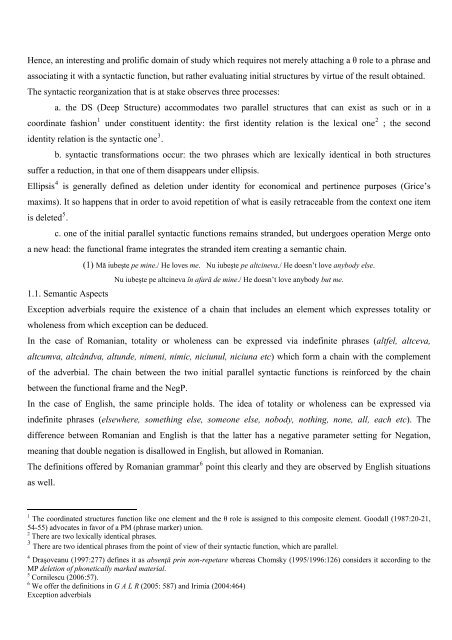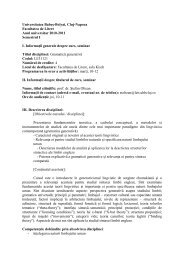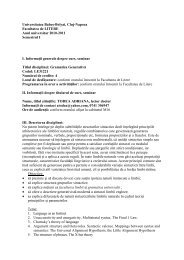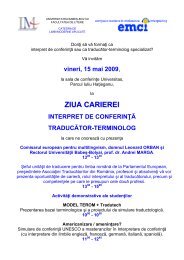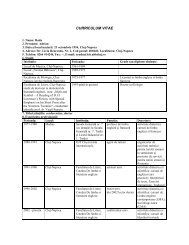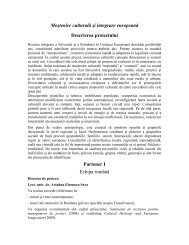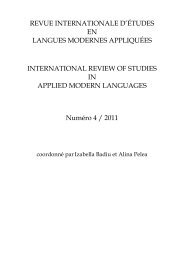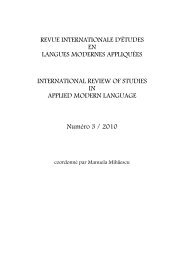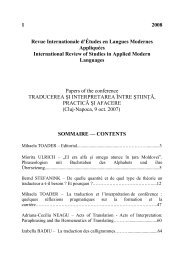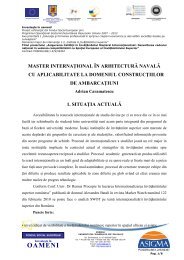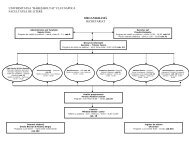Dimensiuni ale limbajului n context carceral
Dimensiuni ale limbajului n context carceral
Dimensiuni ale limbajului n context carceral
Create successful ePaper yourself
Turn your PDF publications into a flip-book with our unique Google optimized e-Paper software.
Hence, an interesting and prolific domain of study which requires not merely attaching a θ role to a phrase and<br />
associating it with a syntactic function, but rather evaluating initial structures by virtue of the result obtained.<br />
The syntactic reorganization that is at stake observes three processes:<br />
a. the DS (Deep Structure) accommodates two parallel structures that can exist as such or in a<br />
coordinate fashion 1 under constituent identity: the first identity relation is the lexical one 2 ; the second<br />
identity relation is the syntactic one 3 .<br />
b. syntactic transformations occur: the two phrases which are lexically identical in both structures<br />
suffer a reduction, in that one of them disappears under ellipsis.<br />
Ellipsis 4 is generally defined as deletion under identity for economical and pertinence purposes (Grice’s<br />
maxims). It so happens that in order to avoid repetition of what is easily retraceable from the <strong>context</strong> one item<br />
is deleted 5 .<br />
c. one of the initial parallel syntactic functions remains stranded, but undergoes operation Merge onto<br />
a new head: the functional frame integrates the stranded item creating a semantic chain.<br />
1.1. Semantic Aspects<br />
(1) Mă iubeşte pe mine./ He loves me. Nu iubeşte pe altcineva./ He doesn’t love anybody else.<br />
Nu iubeşte pe altcineva în afară de mine./ He doesn’t love anybody but me.<br />
Exception adverbials require the existence of a chain that includes an element which expresses totality or<br />
wholeness from which exception can be deduced.<br />
In the case of Romanian, totality or wholeness can be expressed via indefinite phrases (altfel, altceva,<br />
altcumva, altcândva, altunde, nimeni, nimic, niciunul, niciuna etc) which form a chain with the complement<br />
of the adverbial. The chain between the two initial parallel syntactic functions is reinforced by the chain<br />
between the functional frame and the NegP.<br />
In the case of English, the same principle holds. The idea of totality or wholeness can be expressed via<br />
indefinite phrases (elsewhere, something else, someone else, nobody, nothing, none, all, each etc). The<br />
difference between Romanian and English is that the latter has a negative parameter setting for Negation,<br />
meaning that double negation is disallowed in English, but allowed in Romanian.<br />
The definitions offered by Romanian grammar 6 point this clearly and they are observed by English situations<br />
as well.<br />
1<br />
The coordinated structures function like one element and the θ role is assigned to this composite element. Goodall (1987:20-21,<br />
54-55) advocates in favor of a PM (phrase marker) union.<br />
2<br />
There are two lexically identical phrases.<br />
3<br />
There are two identical phrases from the point of view of their syntactic function, which are parallel.<br />
4<br />
Draşoveanu (1997:277) defines it as absenţă prin non-repetare whereas Chomsky (1995/1996:126) considers it according to the<br />
MP deletion of phonetically marked material.<br />
5<br />
Cornilescu (2006:57).<br />
6<br />
We offer the definitions in G A L R (2005: 587) and Irimia (2004:464)<br />
Exception adverbials


